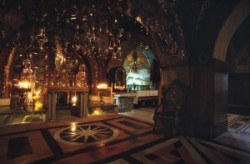
|
Golgotha Chapel.
|
Golgotha Chapel. Church of the Holy Sepulchre. â The Golgotha of today, accessible by step steps, has two chapels side by side, one Roman Catholic and the other Greek Orthodox. On the Roman side are two Stations: where Jesus was stripped of his garments and where he was nailed to the cross. On the Greek side, the 12th Station: where Jesus died on the cross. Under the altar can be seen the top of the rocky outcrop with a silver market where it is believed the cross stood. In between two is the Stabat Mater (Sorrowful Mother) in remembrance of Maryâs agony at her sonâs death.
|
|
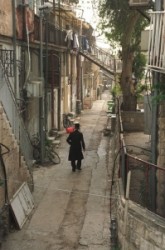
|
Mea She'arim ultra ortodox of Jews
|
Mea She'arim Quarter is home to the ultra ortodox of Jews, some so extreme in their views thet they do not recognise the modern State of Israel because it is not a theocracy. Here in the world unlike any other in Jerusalem, more reminiscent of the 19th century ghettos of Eastern Europe, a whole community leves, trying to avoid the march of time around them. |
|
|
|
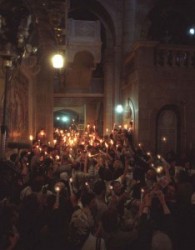
|
Entrance hall
|
Originally built by the mother of Emperor Constantine in 330 A.D., the Church of the Holy Sepulcher commemorates the hill of crucifixion and the tomb of Christ's burial.
On grounds of tradition alone, this church is the best candidate for the location of these events. The Garden Tomb was not identified as such until the 19th century.
|
|
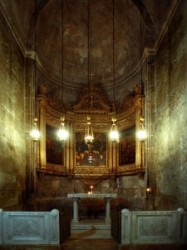
|
Holy Sepulchre
|
The Church of Holy Sepulchre is the most sacred site to Orthodox Christianity in Jerusalem. It was called Golgotha, from the Hebrew world "golgolet" or "skul", wich is what the hill resembled.
And when they were come to the place, which is called Calvary, there they crucified him, and the malefactors, one on the right hand, and the other on the left. Holy Sepulcher ist most sacred space, Holy Sepulchre is a most sacred space,
Then said Jesus, Father, forgive them; for they know not what they do. And they parted his raiment, and cast lots.
Luke 23/33,34
The original Byzantine church was destroyed by the Persians in 614 A.D. Rebuilt shortly thereafter, the Egyptian caliph al-Hakim destroyed the church in 1009 and had the tomb hacked down to bedrock.
The Crusaders rebuilt the church and much of what is standing today is from that time period. The ladder in the upper right window has been there since at least 1860, a testimony to rivalries between the church's factions.
|
|
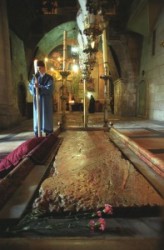
|
Stone of the Unction
|
The Annoninting Stone- Here tradition has it that Jesus was laid when he was taken down from the cross.
His body was sprinkled with a mixture of myrrh and aloe and he was mourned by his mother before being laid in the tomb. |
|
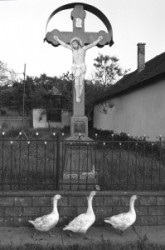
|
Tornabarakony
|
An interconnecting road that starts from KomjÃĄti (a settlement beside the motorway to Slovakia) takes us to Tornabarakony, via TornaszentandrÃĄs. From other directions the village can be approached only by a longish walk of several kilometers. There is a road-sign indicating that we are driving on a Gothic road. At the end of the seven-kilometer long drive, leaving behind a forest, we arrive to a small village with an exceptional landscape. The road looks rather like a long umbilical cord at the end of which there is a quiet and peaceful out-of-the world place. There is no trace of any traffic, only a few elderly people look in our direction with no particular interest. They have got work to do: living their everyday lives, carrying out their work in a leisurely pace. And there is silence!
|
|
|
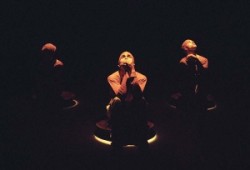
|
Dance
|
In ancient times the contact between dance and the self became indirect as clergy got a leading part in life. |
|
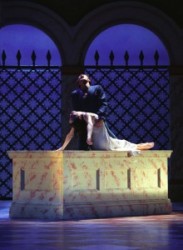
|
Romeo and Juliet
|
Romeo and Juliet. Ballet of GyÅr, Koreographer: Robert North, Music: Szergej Prokofjev, dancer: Szabina CserpÃĄk, BalÃĄzs PÃĄtkai. |
|
|
|
|
|
|
|
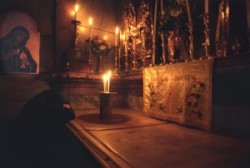
|
Tomb of Jesus Krist.
|
Tomb of Christ: Church of the Holy Sepulchre is one of the most Holy sites in the Christian world, the site of the burial place of Jesus. |
|
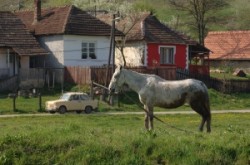
|
Rakaca
|
The settlement is located close to the basin of the valley of the Rakaca stream, on the territory of which was once Borsod-county. Rakaca inherited its Slavic name from a stream traversing the village, a stream that was land marked in the 1249 perambulation.By the first half of the 20th century the settlement was flourishing: it had its own Greek-Catholic public school, general practitioner and post office.Today Rakaca is inhabited by a larger gypsy population cut off from the outside world, deprived of any chances of employment, hoping for outside help to improve their living conditions. |
|
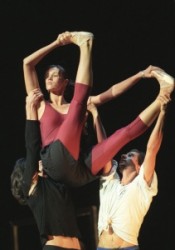
|
Maurice BÃĐjart
|
Maurice BÃĐjart
The French-born Bejart set new standards during a career that spanned five decades, starting with his signature work, the 1959 staging of Stravinsky's "Rite of Spring," in which his dancers -- clad in sleek, shiny tights -- created an erotic aura with impulsive, natural movements that became a standard of âĶ
|
|
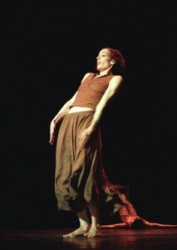
|
BÃĐjart, Juan and Theresa
|
BÃĐjart: Juan and Theresa
The French-born Bejart set new standards during a career that spanned five decades, starting with his signature work, the 1959 staging of Stravinsky's "Rite of Spring," in which his dancers -- clad in sleek, shiny tights -- created an erotic aura with impulsive, natural movements that became a standard of âĶ
|
|
|
|
|
|
|
|
|
|
|
